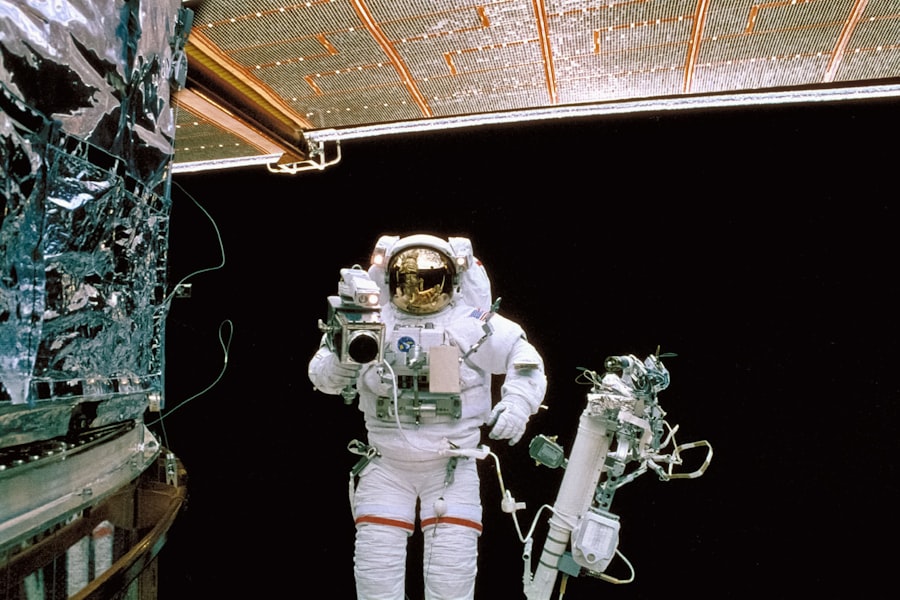Astronautical engineering is a specialized field that focuses on the design, development, and operation of spacecraft and related systems. This discipline encompasses a wide range of activities, from the initial concept and design phases to the actual launch and operation of space vehicles. Astronautical engineers apply principles from various branches of engineering, including mechanical, electrical, and aerospace engineering, to solve complex problems associated with space travel.
The field has gained prominence as humanity’s interest in space exploration has surged, leading to ambitious missions aimed at understanding our universe and expanding our presence beyond Earth. The significance of astronautical engineering extends beyond mere technical prowess; it embodies the spirit of exploration and innovation. As we venture into the cosmos, the challenges faced by engineers in this domain are immense, requiring not only technical knowledge but also creativity and adaptability.
The work of astronautical engineers is pivotal in ensuring the safety and success of missions that may involve human life, scientific research, and the potential for future colonization of other planets. This article delves into the history, roles, challenges, and future prospects of astronautical engineering, highlighting its critical importance in the ongoing quest for knowledge and exploration.
Key Takeaways
- Astronautical engineering involves the design, development, and operation of spacecraft and related technology for space exploration and travel.
- The history of astronautical engineering dates back to the early 20th century and has evolved significantly with advancements in technology and space exploration missions.
- Astronautical engineers play a crucial role in space exploration by designing and testing spacecraft, developing propulsion systems, and ensuring the safety and success of missions.
- Challenges in astronautical engineering include radiation exposure, long-duration space travel, and the need for sustainable and cost-effective technologies.
- The future of astronautical engineering holds opportunities for advancements in propulsion systems, space tourism, and the exploration of Mars and beyond, creating exciting prospects for aspiring engineers.
The History and Evolution of Astronautical Engineering
The roots of astronautical engineering can be traced back to the early 20th century when pioneers like Konstantin Tsiolkovsky and Robert H. Goddard laid the groundwork for modern rocketry. Tsiolkovsky, often referred to as the father of astronautics, formulated the rocket equation that describes how rockets can achieve the velocities necessary for space travel.
His theoretical work inspired subsequent generations of engineers and scientists to explore the possibilities of human spaceflight. Meanwhile, Goddard successfully launched the world’s first liquid-fueled rocket in 1926, marking a significant milestone in the practical application of rocketry. The mid-20th century saw a rapid evolution in astronautical engineering, particularly during the Cold War era when the Space Race between the United States and the Soviet Union ignited unprecedented advancements.
The launch of Sputnik 1 by the Soviet Union in 1957 marked humanity’s first foray into space, prompting a flurry of activity in both nations. The U.S. responded with the establishment of NASA in 1958, which became a central player in astronautical engineering.
The Apollo program, culminating in the historic moon landing in 1969, showcased the remarkable achievements possible through collaboration among engineers, scientists, and astronauts. This period not only advanced technology but also fostered a culture of innovation that continues to influence astronautical engineering today.
The Role of Astronautical Engineers in Space Exploration

Astronautical engineers play a multifaceted role in space exploration, contributing their expertise at various stages of mission development. Their responsibilities encompass designing spacecraft systems that can withstand the harsh conditions of space, including extreme temperatures, radiation exposure, and microgravity environments. Engineers must ensure that all components function seamlessly together, from propulsion systems to life support mechanisms.
This requires a deep understanding of materials science, thermodynamics, fluid dynamics, and control systems. In addition to design and development, astronautical engineers are heavily involved in testing and validation processes. Before any spacecraft is launched, extensive simulations and tests are conducted to ensure that systems will perform as expected under real-world conditions.
For instance, engineers utilize wind tunnels to study aerodynamic properties and conduct vibration tests to simulate launch conditions. Furthermore, they analyze data from previous missions to refine designs and improve reliability. The iterative nature of this process underscores the importance of thorough testing in mitigating risks associated with space travel.
Challenges and Innovations in Astronautical Engineering
| Challenges | Innovations |
|---|---|
| Microgravity effects on human body | Development of exercise equipment for space |
| Radiation exposure in space | Advancements in shielding materials |
| Life support systems for long-duration missions | Bioregenerative life support systems |
| Space debris and collision avoidance | Improved tracking and maneuvering technologies |
The field of astronautical engineering is fraught with challenges that require innovative solutions. One significant challenge is the development of propulsion systems capable of efficiently transporting payloads beyond Earth’s atmosphere. Traditional chemical rockets have limitations in terms of fuel efficiency and thrust-to-weight ratios.
As a result, researchers are exploring alternative propulsion methods such as ion propulsion and nuclear thermal propulsion. These technologies promise to reduce travel times for deep-space missions while minimizing fuel consumption. Another pressing challenge is ensuring the safety and well-being of astronauts during long-duration missions.
As missions extend beyond low Earth orbit—such as those planned for Mars—engineers must address issues related to radiation exposure, psychological stress, and life support sustainability. Innovations in habitat design are being explored to create environments that can support human life for extended periods while providing protection from cosmic radiation. For example, concepts for Martian habitats include using local materials for construction and incorporating advanced life support systems that recycle air and water.
The Future of Astronautical Engineering: Advancements and Opportunities
Looking ahead, astronautical engineering is poised for transformative advancements driven by emerging technologies and increased collaboration among nations and private enterprises. The advent of reusable launch systems has already begun to revolutionize access to space by significantly reducing costs associated with satellite deployment and crewed missions. Companies like SpaceX have demonstrated the feasibility of reusing rocket stages, paving the way for more frequent launches and greater accessibility to space.
Moreover, advancements in artificial intelligence (AI) and machine learning are set to enhance mission planning and operations. AI algorithms can analyze vast amounts of data from previous missions to optimize trajectories, improve navigation systems, and even assist astronauts during complex tasks aboard spacecraft. As we venture further into deep space exploration—such as missions to asteroids or beyond Mars—autonomous systems will become increasingly vital for managing spacecraft operations without constant human oversight.
Educational and Career Paths in Astronautical Engineering

Pursuing a career in astronautical engineering typically begins with a strong educational foundation in engineering or a related field. Most aspiring engineers earn a bachelor’s degree in aerospace engineering or mechanical engineering, where they gain essential knowledge in fluid dynamics, structural analysis, propulsion systems, and control theory. Many universities offer specialized programs or concentrations in astronautics that provide students with targeted coursework relevant to space exploration.
Beyond undergraduate education, many professionals choose to pursue advanced degrees—such as master’s or doctoral programs—to deepen their expertise or engage in research initiatives. Graduate studies often involve hands-on projects that allow students to work on real-world problems faced by the aerospace industry. Internships at organizations like NASA or private aerospace companies provide invaluable experience and networking opportunities that can significantly enhance career prospects.
Collaboration and Interdisciplinary Work in Astronautical Engineering
The complexity of astronautical engineering necessitates collaboration across various disciplines. Engineers often work alongside scientists from fields such as physics, materials science, biology, and computer science to address multifaceted challenges associated with space exploration. For instance, developing life support systems requires input from biologists who understand human physiology as well as engineers who can design efficient recycling systems for air and water.
International collaboration has also become increasingly important in astronautical engineering. Projects like the International Space Station (ISS) exemplify how countries can pool resources and expertise to achieve common goals in space exploration. Engineers from different nations contribute their unique perspectives and skills to create a platform for scientific research that benefits humanity as a whole.
This collaborative spirit fosters innovation while promoting peaceful cooperation among nations.
Ethical and Environmental Considerations in Astronautical Engineering
As humanity expands its reach into space, ethical considerations surrounding astronautical engineering become paramount. The potential for contamination of other celestial bodies raises concerns about planetary protection protocols that must be adhered to during mission planning. Ensuring that spacecraft do not inadvertently introduce Earth-based microorganisms to other planets is crucial for preserving extraterrestrial ecosystems.
Additionally, environmental considerations extend beyond planetary protection; they also encompass the sustainability of space activities themselves. The increasing number of satellites in orbit has led to concerns about space debris—a growing hazard that poses risks to operational spacecraft and future missions. Engineers are actively exploring solutions such as debris tracking systems and technologies for deorbiting defunct satellites to mitigate these risks.
In conclusion, astronautical engineering stands at the forefront of human exploration beyond our planet. As we continue to push the boundaries of what is possible in space travel, the contributions of engineers will be vital in overcoming challenges while ensuring ethical practices guide our endeavors into the cosmos. The future holds immense promise for advancements that will not only enhance our understanding of the universe but also inspire generations to come.


